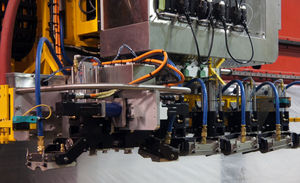
- Metrology - Laboratory
- Inspection and Monitoring
- Ultrasonic inspection system
- Evident - Olympus Scientific Solutions
- Company
- Products
- Catalogs
- News & Trends
- Exhibitions
Ultrasonic inspection system LSAWautomatedqualityfor welded pipes

Add to favorites
Compare this product
Characteristics
- Technology
- ultrasonic
- Operational mode
- automated
- Type
- quality
- Product applications
- for welded pipes
Description
Longitudinal submerged arc welded (LSAW) tubes are manufactured by bending and molding steel plate and then joining the edges using a double-sided submerged arc weld. They are commonly used in the oil and gas industry for long-distance hydrocarbon transport pipelines.
Olympus Longitudinal Submerged Arc Weld (LSAW) Inspection System
Olympus’ LSAW high-performance tube and weld inspection solution uses ultrasonic phased array probes integrated into fully automated testing systems to meet stringent requirements for weld-volume inspection. The LSAW system helps manufacturers ensure the quality of longitudinal submerged arc welded tubes and can be adapted to meet the varying needs of oil country tubular goods (OCTG) manufacturers.
LSAW Pipe Inspection Requirements
The LSAW system is built to comply with international standards governing pipe manufacturing inspection requirements. It inspects 100% of the weld volume in line pipes ranging from 304.8 mm to 2032 mm (12 in. to 80 in.) OD, in addition to the heat affected zone (HAZ).
Detected defects:
• Longitudinal and transverse cracks (up to 3 mm (0.12 in.) ID and OD for each side)
• Lack of fusion, lack of penetration, and penetrators according to the wall thickness (DEP standard*)
• Lamination defects in the HAZ (up to 75 mm (3 in.) for each side of the weld)
LSAW Automated Turnkey Solution Features
Integrating the LSAW inspection system into the quality control process enables manufacturers to:
• Minimize dependency on operator skill, owing to the system’s automatic calibration
• Detect defects at normal production speed with regular calibration checks
• Limit the overall dimensions of the inspection head
Catalogs
Other Evident - Olympus Scientific Solutions products
Tube Inspection Solutions
Related Searches
- Digital camera module
- Visible camera system
- CMOS camera module
- Full-color camera system
- USB camera module
- High-definition camera
- Evident Olympus inspection system
- Inspection camera system
- USB 3.0 imager
- Spark optical emission camera system
- Evident Olympus endoscope
- Laboratory imager
- Megapixel camera system
- Evident Olympus automatic inspection system
- Full HD camera module
- Data acquisition module
- Evident Olympus flexible endoscope
- Machine vision lens
- 4K camera
- High-resolution lens
*Prices are pre-tax. They exclude delivery charges and customs duties and do not include additional charges for installation or activation options. Prices are indicative only and may vary by country, with changes to the cost of raw materials and exchange rates.








